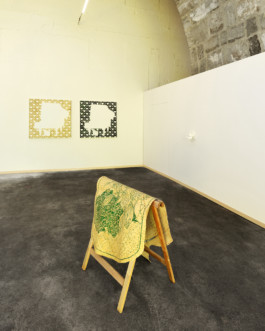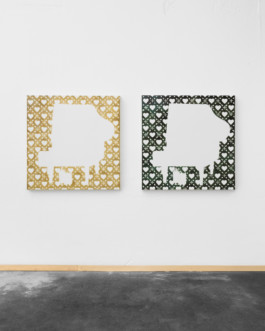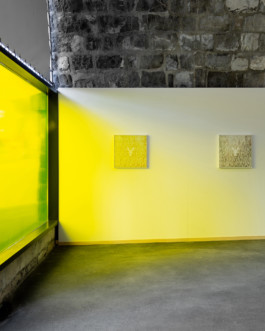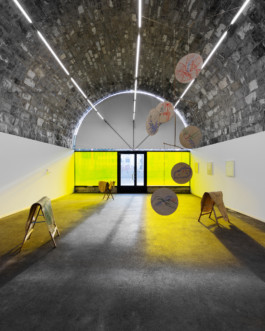












"To make a home is to inhabit a space as one’s own, to be ‘at home.’ To make a home is not to fill it with objects, but to ‘inhabit’ the world as an object to be filled. Inhabiting the world as an object to be filled is about finding an orientation, which is an attunement. A sense of home is a sense of being oriented within one’s surroundings. When we find an orientation, we are not simply oriented; we also find that we are orientated. […] In becoming orientated, we move toward something, we face a certain direction, we are headed somewhere."
While feeling a sense of orientation or purpose maybe an anomaly today, in Queer Phenomenology: Orientations, Objects, Others (2006) writer and scholar Sara Ahmed reminds us of the importance of considering the world as our home. Although Melanie Akeret, Luana Cardinaux and Sergio Rojas Chaves focus on different spaces, places and practices, the beauty and fragility of those particular sites, their history and voids (sometimes metaphorical, geographical or even literal), are always part of the artists’ works. Interested in interior and exterior spaces alike, the exhibition becomes the very site where these boundaries become blurred: the large windows overlooking the Route de Bel-Air and the weathered, historically preserved stones of the arch face the wooden skirting boards, that gently embrace and unite the three white walls.
For her paintings, Melanie Akeret (Zürich) uses repetitive, almost interchangeable motifs, such as lobsters and pianos, as empty spaces in front of wallpaper-like backdrops. By inverting foreground and background, the artist breaks down conventional painterly boundaries and exposes their artificiality as well as their potential for serious self-assertion and humorous commentary alike.
Profoundly interested in the seemingly colorful iconography of childhood, Luana Cardinaux (Lausanne) takes a closer look at their ambiguous discords and our strange adult detachment from them. To any 90s kid, the collapsible sculptures might be reminiscent of the small plastic playsets known as “Polly Pockets”. Entirely in white, however, the artist displays a series of four ghostlike bedrooms.
Sergio Rojas Chaves (Costa Rica/Basel) focusses on our intricate relationship with plants and other beings. His artistic research results in a playful approach to those entities that often lie under a veil of postcolonial ignorance and assumed human superiority. Painted on petates (woven palm mats), oversized bottle gardens nestle on wooden structures, while illustrations for propagating plants gently move as a mobile.
"To make a home is to inhabit a space as one’s own, to be ‘at home.’ To make a home is not to fill it with objects, but to ‘inhabit’ the world as an object to be filled. Inhabiting the world as an object to be filled is about finding an orientation, which is an attunement. A sense of home is a sense of being oriented within one’s surroundings. When we find an orientation, we are not simply oriented; we also find that we are orientated. […] In becoming orientated, we move toward something, we face a certain direction, we are headed somewhere."
While feeling a sense of orientation or purpose maybe an anomaly today, in Queer Phenomenology: Orientations, Objects, Others (2006) writer and scholar Sara Ahmed reminds us of the importance of considering the world as our home. Although Melanie Akeret, Luana Cardinaux and Sergio Rojas Chaves focus on different spaces, places and practices, the beauty and fragility of those particular sites, their history and voids (sometimes metaphorical, geographical or even literal), are always part of the artists’ works. Interested in interior and exterior spaces alike, the exhibition becomes the very site where these boundaries become blurred: the large windows overlooking the Route de Bel-Air and the weathered, historically preserved stones of the arch face the wooden skirting boards, that gently embrace and unite the three white walls.
For her paintings, Melanie Akeret (Zürich) uses repetitive, almost interchangeable motifs, such as lobsters and pianos, as empty spaces in front of wallpaper-like backdrops. By inverting foreground and background, the artist breaks down conventional painterly boundaries and exposes their artificiality as well as their potential for serious self-assertion and humorous commentary alike.
Profoundly interested in the seemingly colorful iconography of childhood, Luana Cardinaux (Lausanne) takes a closer look at their ambiguous discords and our strange adult detachment from them. To any 90s kid, the collapsible sculptures might be reminiscent of the small plastic playsets known as “Polly Pockets”. Entirely in white, however, the artist displays a series of four ghostlike bedrooms.
Sergio Rojas Chaves (Costa Rica/Basel) focusses on our intricate relationship with plants and other beings. His artistic research results in a playful approach to those entities that often lie under a veil of postcolonial ignorance and assumed human superiority. Painted on petates (woven palm mats), oversized bottle gardens nestle on wooden structures, while illustrations for propagating plants gently move as a mobile.














